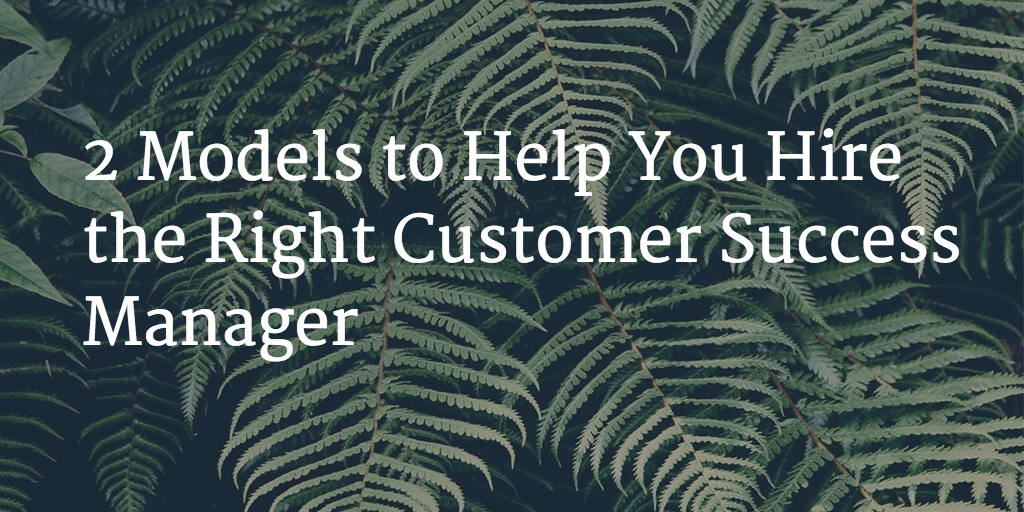Asking the question “what should I look for in a CSM?” is like asking “what kind of person do I need to fill my Sales role?” Any answer other than “it depends” is either naïve or based on a set of assumptions. So, let’s start by talking about the different ways a Customer Success organization can operate.
Although this is ultimately a spectrum, I’ll discuss the two ends of the spectrum as if they are completely distinct and you have to choose one or the other. I would suggest that you do think long and hard about which model best fits what you are trying to accomplish, as that will drive a number of decisions including what kind of person you will hire.
Model 1 – CSMs as Air Traffic Controllers
One of the challenges that is very prevalent in, but not exclusive to, SaaS companies is the confusion customers often have because of the number of different people who touch them, especially early in their lifecycle. In the most extreme case, a customer could interact with as many as a dozen different individuals (even counting Customer Support as only one person). Their life as a customer obviously starts with their Sales Rep and Sales Consultant. After the initial deal is done, they may interact with someone doing the provisioning of their system. Then they’ll be handed off to OnBoarding and Training and then, after the implementation is complete, to their Customer Success Manager.
Along the way towards their first anniversary, they will certainly talk to Customer Support, probably several times. There’s also a good chance that a different Sales Rep, responsible for Install Base Sales, will try to sell them additional products. If they need Services beyond the initial implementation, they may interact with an Engagement Manager who will scope the effort and do the SOW before handing them off to their Project Manager and Consultant(s). If there is a physical renewal required, a different person from all of the above may handle that. Whew. I’m exhausted and confused just from writing that. Imagine how the customer might feel?
You can see why there’s a strong temptation, and a good rationale, to align the customer with one individual who will be their primary point of contact throughout their lifecycle. If that decision is made, it’s logical that the task will fall to Customer Success. That’s what I mean when I say “air traffic controller.” It’s a person who manages the customer but, in the end, is primarily responsible for directing them to the right resource for their current need. As with almost any decision, there are pros and cons to this model:
Pros
- Less expensive resource than a product expert (Model 2)
- Customer really does have a single-point-of-contact
- Ultimate ownership of the customer resides in one place
- Easier to find people who can fill this role
Cons
- The role can be less fulfilling personally
- The direct value to the customer is somewhat minimized
- Over time, customers will figure out (or try unsuccessfully with bad consequences) how to bypass the ATC to get directly to someone who can truly help them
- The role can be abused, often by your lowest-paying customers who refuse to become self-sufficient
- The role may be lower-paying and not widely respected, but often requires a high degree of influence skill. Those two things are often mutually exclusive.
Skill Requirements for Model 1
- Good customer-facing skills
- Ability to handle difficult situations with customers
- Beginner-level project management (keeping customer informed and properly setting expectations)
- Excellent influence skills
- Solid written and verbal communication skills
Model 2 – CSMs as Product Experts
This is pretty easy to define. It’s essentially the same skillset that is required for those doing Consulting and OnBoarding. I see the requirements for this role as a three-legged stool:
1. Great customer-facing/customer management skills
2. Ability to become a true product expert
3. Has, or can quickly obtain, domain expertise
This person will be the go-to guy/gal for their customers. They need to be able to handle 80% of all non-Support issues. They need to be deeply conversant with their product(s) and also have a solid working knowledge of the domain and best practices. Many of their interactions with customers will have less to do with your product than they do with the best practices around your domain.
The good news is that the highest value for your customers comes from the combination of those last two elements. After all, you built the best product in your space, right? You want your customers using it with the best practices in the market. So, if you go towards this model and find the right people, your customers are likely to LOVE them, which causes a whole ‘nother set of problems.
Because this brand of CSM is much more expensive than the air traffic controller, a decision to go this route will often lead to another very important decision. Should you, or should you not, assign a CSM to every single customer? Is it legal, or possible, to manage customers with any degree of success, in a pooled model? This is an important topic but will have to wait for another blog post. I wanted to bring it up just to make the point that the Air Traffic Controller vs. Product Expert decision has ramifications in other areas.
So, what are the pros and cons of Model 2?
Pros
- Customers go straight to the person who can usually help them
- Customer sat and renewals will typically be better in this model
- This can solve the single-point-of-contact challenge
- You’ll end up having to implement this
Cons
- More expensive resources
- More challenging to switch accounts between CSMs
- Much harder to be a product expert if you have several products
- If you pool customers, instead of assigning a CSM to each one, you haven’t really solved the single-point-of-contact challenge
- These CSMs will be really valuable on the open market and to other parts of your Services organization
- If a CSM is assigned to every customer, your low value customers can take up a disproportionate amount of a CSM’s time
This is a difficult decision to say the least. You can certainly try to come up with some kind of hybrid model and that could work. But you are most likely to end up with a model that is closer to one end of the spectrum than the other. Again, this is a situation where there are no right or wrong answers, just decisions with different consequences. I’d like to say that one model is clearly better than the other but there are too many dependencies to say that, especially what kind of product(s) you are selling. In general, I do favor the Product Expert model for the “pros” listed above.
I just think the model where the customer is seldom getting direct help from the person they are designated to call, breaks down too easily and too quickly. When a customer starts to get expertise from someone, they will almost always start going directly to that person at some point. Enforcing a different process often leads to frustration and dissatisfaction on the part of the customer.
My advice is this – think long and hard about this decision and talk to lots of people outside your company about it. Especially those with scars that prove they’ve done it before. And figure out how to start automating some of the CSM’s workload. If an application makes good sense for every other organization in your company, why not for Customer Success? It’s at least as important as HR, isn’t it?

